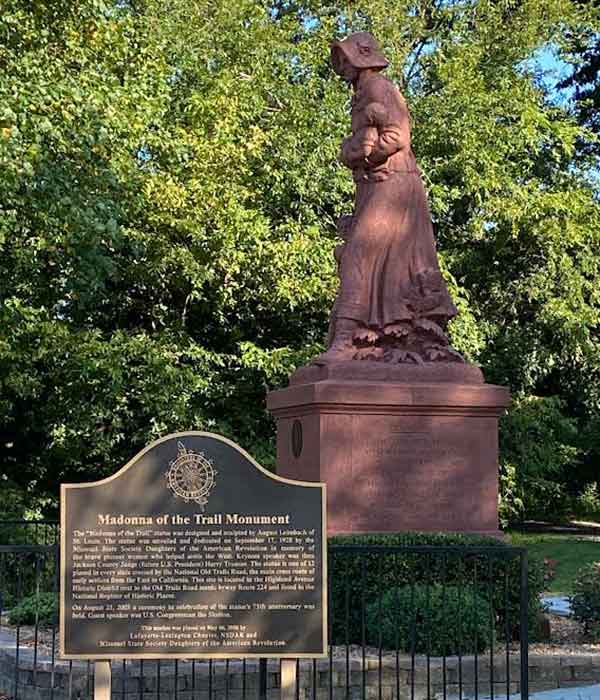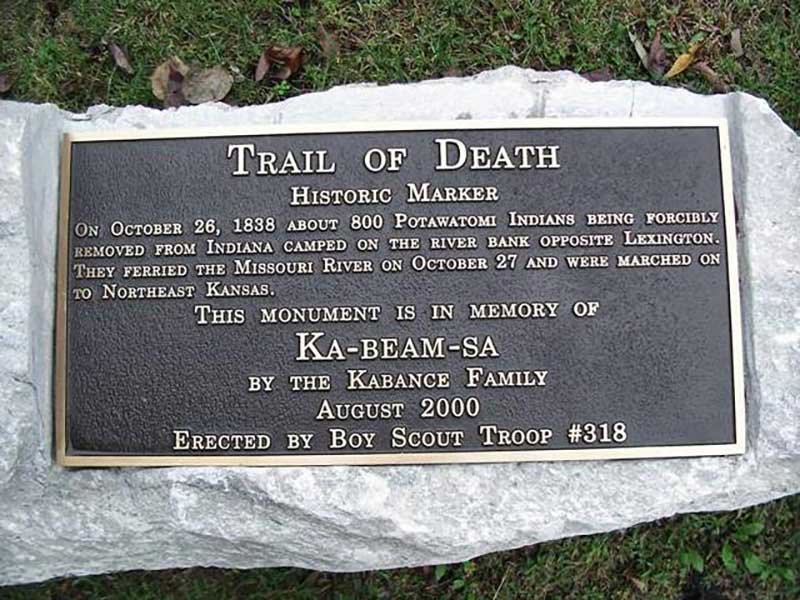This article is presented in partnership with Lexington Tourism.
Along the south side of the Missouri River, between Lexington and Wellington, is an old curving highway, which served as an early portion of the Santa Fe Trail as it headed west, towards Independence. Perched along the river bluff in Lexington, is a small park commemorating those who traveled this trail.
Commissioned by the Daughters of the American Revolution (DAR), the Madonna of the Trail Monument is one of 12 identical statues stretching from Maryland to California, depicting pioneer women migrating along 19th-century western trails.
The project for the statues began when a group of Missouri women decided to commemorate the Santa Fe Trail route. In 1911, DAR set out to mark the “Old Trails Road” and in 1927, National Old Trails Association President, Harry S. Truman, and President Coolidge received congressional approval for the creation of a National Memorial Highway stretching from the Atlantic to the Pacific.
Planning and work on the twelve statues took nineteen years, while briefly being halted for WWI. In 1927, August Leimbach was chosen to be the artist for the five-ton sculpture. Standing eighteen feet tall, including the base, the Madonna is depicted as a courageous woman in pioneer dress, with a baby in her left arm and a rifle in her right. Another child clutches at her skirts as she faces West, while a rattlesnake peaks out from under the prairie grass below her feet.

The reddish hue of the statue comes from algonite, of which crushed Missouri granite is the main aggregate. The statues were placed along key white migration routes. The location of the monument within each state was selected based on both the site’s historical significance, and the influence of local DAR and National Old Trails Association chapters.
On September 17, 1928 the Missouri Madonna of the Trail was dedicated in Lexington by Harry S. Truman, who was also the keynote speaker. At the time, Truman had been elected the presiding Jackson County Judge, (today’s County Commissioner position.) Ninety-three years later, in time for the Missouri Bicentennial year, the DAR again held a celebration on August 7, 2021 recognizing the complete restoration of the Madonna statue, which is still situated in its original location.
A few feet from the Madonna statue is an unassuming boulder with a small memorial plaque and sign, marking the site as part of the Trail of Death, and the forced removal of the Potawatomi from Indiana to Kansas.
After the 1830 passage of the Indian Removal Act, the Potowatami were being displaced from their ancestral lands in Indiana as more white settlers began moving West. The last 859 members of the Potawatomi still living there suffered a forced removal, at gunpoint, by a Federally appointed militia. During the journey of approximately 660 miles, more than 40 persons died, many of them children. They were buried in unmarked graves along the trail.
On October 26, 1838 the Army wagons and Potowatami goods were ferried across the Missouri River from Ray County to Lexington. The next day, the people were brought across the river and the march continued west along the current Highway 224 to Wellington, where they camped on October 27th.
In 1988, the Potawatomi Trail of Death Association took on the project of getting Trail of Death historical markers at each camp site, every 15 to 20 miles, from Indiana to Kansas. When the goal was reached in 2003, the
Trail of Death Commemorative Caravan retraced the original route for the fourth time, having also traveled in every five years. The most recent caravan occurred in 2018.

David Thomas Anderson, of Seattle, Washington, who is a member of the Citizen Potawatomi Nation, designed the logo for the Trail of Death Regional Historic Trail. There are now 80 memorial markers and 150 historic Potawatomi Trail of Death highway signs along the four state route.
The Lexington memorial was placed in August of 2000, with the assistance of Boy Scout Troop #318.
The Madonna of the Trail Monument and the Trail of Death memorial are located at the intersection of Hwy 224 and Highland Ave, in the Highland Historic District. Both the self-guided audio tour and map are downloadable at visitlexingtonmo.com


